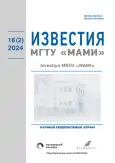Geometry, kinematics and dynamics of the Mecanum wheel. Unstable motion of the Mecanum vehicle
- Authors: Dyakov A.S.1, Fedorov D.S.1
-
Affiliations:
- Bauman Moscow State Technical University
- Issue: Vol 18, No 2 (2024)
- Pages: 139-148
- Section: Transport and transport-technological facilities
- URL: https://ogarev-online.ru/2074-0530/article/view/268205
- DOI: https://doi.org/10.17816/2074-0530-629873
- ID: 268205
Cite item
Full Text
Abstract
BACKGROUND: The Mecanum wheels enable the vehicle to move in any desired direction and increase its mobility when moving along a flat surface. When designing a vehicle, the design loads determine the required driving moments and, as a result, the characteristics of the drivetrain. Thus, determining the loads acting on the Mecanum wheels in stationery and transition events is the most relevant task related to the Mecanum wheel.
AIM: Determination of the traction characteristics of the Mecanum wheel drives, ensuring the given mobility of the vehicle.
METHODS: Simulation of motion of a vehicle with the Mecanum wheels is carried out in the multibody dynamics’ software package. The contact interaction of the Mecanum wheel and rollers with the surface is described on the basis of the rolling theory.
RESULTS: A simple descriptive method for building a roller profile is proposed. The velocities of the vehicle, wheels and rollers for various directions and modes of motion, are calculated. The driving torque required for motion at these velocities is presented.
CONCLUSION: The Mecanum vehicle model makes it possible to determine the kinematic and dynamic characteristics of motion along a flat support in any mode of motion.
Keywords
Full Text
##article.viewOnOriginalSite##About the authors
Alexey S. Dyakov
Bauman Moscow State Technical University
Email: Diakov_as@bmstu.ru
ORCID iD: 0009-0005-7787-2354
SPIN-code: 9437-8400
Dr. Sci. (Engineering), Professor of the Wheeled Vehicles Department
Russian Federation, MoscowDmitry S. Fedorov
Bauman Moscow State Technical University
Author for correspondence.
Email: fedor0v_dmitrii@mail.ru
ORCID iD: 0009-0006-6141-7864
SPIN-code: 9122-5314
Student of the Multipurpose Tracked Vehicles and Mobile Robots Department
Russian Federation, MoscowReferences
- Patent Sweden B60B 19/12 (20060101); B60b 019/00, REF/3876255 (Nov 13, 1972). Ilon BE. Wheels for a Course Stable Selfpropelling Vehicle Movable in Any Desired Direction on the Ground or Some Other Base.
- Hendzel Z., Rykała Ł. Description of Kinematics of a Wheeled Mobile Robot with Mecanum Wheels. Modelowanie Inżynierskie. 2015;26(57):5–12.
- Adamov B.I., Kobrin A.I. Parametric Identification of the Mathematical Model of the Omnidirectional Mobile Robot KUKA youBot. Mekhatronika, Avtomatizatsiya, Upravlenie. 2018;19(4):251–258 (In Russ).
- Adamov BI. Influence of Mecanum Wheels Construction on Accuracy of the Omnidirectional Platform Navigation (on Example of KUKA youBot Robot). In: Proc. of the 25th Ann. Saint Petersburg Internat. Conf. on Integrated Navigation Systems. 2018:251–254. doi: 10.23919/ICINS.2018.8405889
- Adamov BI, Saipulaev GR. Research on the Dynamics of an Omnidirectional Platform Taking into Account Real Design of Mecanum Wheels (As Exemplified by KUKA youBot). Russian Journal of Nonlinear Dynamics. 2020;16(2):291–307. EDN: SJBJQO
- Larin VV. Teoriya dvizheniya polnoprivodnyh kolesnyh mashin. Moscow: MGTU im NE Baumana; 2010. EDN: QNWYGX
- Gfrerrer A. Geometry and Kinematics of the Mecanum Wheel. Comput. Aided Geom. Des. 2008;25(9):784–791. doi: 10.1016/j.cagd.2008.07.008
- Universal mechanism 9. User manual [internet] cited: 25.02.2024. Available from: https://www.umlab.ru.
Supplementary files
















